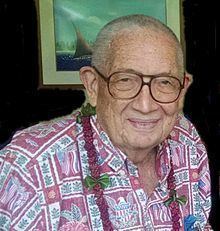Residence United States | Nationality American | |
 | ||
Fields Chemistry, Numerical Modeling, Explosives, and Tsunami Waves Institutions Los Alamos National Laboratory
Mader Consulting Co. Alma maters Oklahoma State University–Stillwater, California Miramar University Institution Los Alamos National Laboratory | ||
Charles Lavern Mader (born 1930) is an American physical chemist known for his work in the fluid dynamics of explosives and water waves. He is a Laboratory Fellow of Los Alamos National Laboratory. He wrote several books on numerical modeling of explosives, propellants, and water waves, and he authored or co-authored over 160 technical papers.
Contents
Education and career
Charles L. Mader was a Banning Scholar at Oklahoma City University (1948-1951) and earned his B.S. and M.S. degrees in chemistry from Oklahoma A&M College (now known as Oklahoma State University–Stillwater) (1951-1954). His Master’s thesis was on quantitative measurements of the organic acids of sorghum syrup.
During his graduate studies at University of Kansas (1954-1955), he was a 1954 Summer graduate student at Los Alamos Scientific Laboratory (subsequently known as Los Alamos National Laboratory) in New Mexico. He joined Los Alamos as a Staff Member in the Explosive Division (GMX) (1955-1966) and continued in the Theoretical Division (1966-1986). He obtained his Ph.D. from Pacific Western University, Encino, CA (1980). After retirement from Los Alamos, he has continued to research and publish.
Mader’s expertise has been drawn upon by many, including the Beijing Institute of Technology; the Joint Institute for Marine and Atmospheric Research (JIMAR) at the University of Hawaii at Manoa; the Center for Explosives Technology Research (CETR) at the New Mexico Institute of Mining and Technology; the Department of Physics at University of New Mexico; the Department of Oceanography at the University of Hawaii; and the Department of Marine Science at Hawaii Pacific University. He is currently a Distinguished Scientist of the Energetics Research Institute (EnRI) at Nanyang Technology University, Singapore.
Scientific contributions
Mader’s research involved the study of the physical chemistry of detonations, explosives, and propellants through laboratory experiments, atmospheric and underground testing, and numerical modeling. He used the numerical models that he developed to predict results that were then experimentally verified. His models also were used to reproduce results derived from previously acquired experimental data. Mader and J. Zinn developed numerical solutions for nonlinear heat conduction equations that agreed with experimental data (1960). Using the Los Alamos IBM-7030 STRETCH computer and the Becker-Kistiakowsky-Wilson equations of state, he developed computer models for the detonation properties of explosives (1963). Using the Los Alamos PHERMEX (Pulsed High-Energy Radiographic Machine Emitting X-rays), he and colleagues extracted experimental data from flash radiographs of explosives and explosive-driven metal systems (1980), (1983).
His book "Numerical Modeling of Detonations" (1979) surveys two decades of numerical modeling of the detonation process for condensed explosives and describes the numerical methods and the reactive dynamics of these materials. His book "Numerical Modeling of Explosives and Propellants" (2007) became a standard text on the chemistry and fluid dynamics of chemical explosive devices.
Mader applied his expertise in fluid dynamics to research in the numerical modeling of tsunamis (1974) and other water waves. Using the full Navier-Stokes AMR (adaptive mesh refinement) Eulerian compressible hydrodynamic computer code called SAGE (SAIC Adaptive Grid Eulerian), software developed by SAIC and Los Alamos, he modeled landslide tsunami hazards, such as the 1958 Lituya Bay megatsunami (2002) and the 1883 eruption of Krakatoa (2006). His models are used to evaluate tsunami flooding and to determine which areas need to be evacuated.
His book "Numerical Modeling of Water Waves" (2004) is a "comprehensive treatise of the evolving science of computer modeling of waves."
Personal life
Mader, married to his wife Emma Jean for over 56 years, is an accomplished mountaineer and downhill skier. He was the 65 person to have climbed (1959) all 54 Colorado peaks above 14,000 feet. He and his wife skied sixty years and after marking his 80th birthday, he skied 1.5 million vertical feet. He is devoted to the Boy Scouts of America, serving as Scoutmaster in Los Alamos (1972-1984) and mentoring 48 Scouts to earn their Eagle rank. He is a 3 Bead Woodbadger and was awarded the Silver Beaver (1984). Currently, he is a District Commissioner in the Aloha Council of the Boy Scouts.
